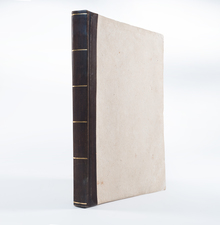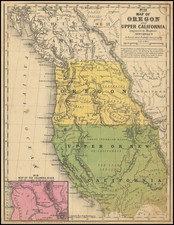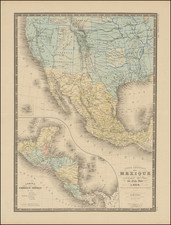The Most Detailed Mapping of 1920s Florence, Arizona
A fire insurance atlas of Florence, Pinal County, produced by the Sanborn Map Company in June 1915, and updated to July 1927. The atlas offers a detailed record of the built environment of an Arizona town. Comprising 2 unbound sheets with hand-colored maps, the atlas was originally made as a specialized tool for insurance company underwriters in determining the degree of fire risk associated with any property shown therein. Today it is an unrivaled visual record of Florence's urban and architectural landscape for the time.
Use of every structure is given: dwelling, grocery, storage, lumber yard, barbershop, corral, auto garage, pool hall, church, hardware, water tower, etc., with the name of the individual business owner or public building noted. Color coding denotes building material. Notably, several buildings are noted as adobe structures.
Noted Murder Trials
During the 1920s, Florence, Arizona, a town of 1000 inhabitants located in Pinal County, was primarily an agricultural hub - anchored by cotton farming and cattle ranching, facilitated by the proximity of the Gila River. The town was home to the Arizona State Prison, established in 1908, which was a significant employer. The Pinal County Court House, which is illustrated on the second sheet of the atlas, was the scene of several sensational murder trials, including those of Eva Dugan and Winnie Ruth Judd. Dugan, who was sentenced to death by hanging, was unintentionally decapitated on February 21, 1930, when the noose around her neck severed her head. This incident caused Arizona to change its execution method, to gas chamber, and later to lethal injection.
Although the decade of the 1920s saw modest growth in Florence (attested here by the extensive July 1927 pasted-on slips which updated the present 1915 edtion atlas), Florence's core identity as a center for agriculture and governance as the county seat, continued steadily. Today the city of Florence has a population of 26,000.
A selection of structures noted in the atlas here follows:
- Hotel Florence
- Pinal Lumber Co.
- Florence Improvement Co.
- Pinal County Court House and Jail - the site of several sensational murder cases
- Municipal Pumping Station
- Church of the Assumption (Roman Catholic) - Priests' dwelling adobe construction
Fire insurance maps were designed to assist insurance underwriters in determining the degree of risk associated with almost any property. For nearly a century (from 1867 to 1961), Sanborn Map Company produced their fire insurance maps for nearly all U.S. cities. Ron Tyler (Prints of the West, pages 153-55) describes the fire insurance maps as a successor to the bird’s-eye view in documenting the growth of towns and cities.
Rarity
The Florence, Arizona Sanborn atlas is very rare in the market. Our example is almost certainly the unique surviving exemplar of the
OCLC locates a single example of an unidentified edition of the Florence atlas at the University of Arizona. The Library of Congress has digitized a base 1915 edition as well as an updated-to-1941 edition, both of which differ substantially from our updated-to-1927 edition.
The Sanborn Map Company, founded in the 1860s by Daniel Alfred Sanborn, is a renowned cartographic institution primarily recognized for its unparalleled fire insurance atlases. These atlases emerged as indispensable tools during the late 19th and early 20th centuries, portraying the evolution of urban America with unprecedented detail and precision. Charting both burgeoning metropolises and smaller municipalities, Sanborn's fire insurance maps provide a unique and illuminating perspective on the physical, economic, and social transformation of the nation during a period of intense urbanization and industrialization.
During the latter half of the 19th century, the United States witnessed an acceleration in urban growth. This shift from rural to urban living, bolstered by the advent of the Industrial Revolution, generated densely populated areas with a diverse array of architectural styles, materials, and infrastructure. In this context, the need for comprehensive maps that could illustrate the specifics of the built urban fabric became paramount, especially for insurance companies seeking to assess the risks associated with insuring individual properties. The Sanborn Map Company responded to this demand, creating elaborate maps that identified building materials, the purpose of structures, and even features like fire walls and sprinkler systems.
A standout feature of Sanborn's maps was their color-coding system, which allowed for a swift and clear differentiation between building materials—whether wood, brick, iron, or otherwise. This system, paired with the company's legends -- detailing everything from the width of streets to the locations of hydrants -- made these atlases an invaluable resource for insurance underwriters. By the turn of the 20th century, Sanborn maps covered thousands of cities and towns across the United States.
Beyond their utility to the insurance industry, the atlases produced by the Sanborn Map Company have, over time, become a treasured resource for historians, urban planners, preservationists, and environmental researchers. These maps have also been pivotal in brownfield research, shedding light on past industrial activities and potential contamination sites. They offer a window into the past, capturing the architectural, infrastructural, and environmental trends of various eras, and revealing the intricacies of a city's development. The very design of streets, the evolution of residential and commercial areas, and the rise and decline of certain industries can be traced through these maps.
Around 1960, Warren Buffett, then a burgeoning value investor, took a significant position in Sanborn Map Co., sinking 35% of his partnership's money into the company. Buffett was drawn to Sanborn's extensive map business, which he described as a virtual monopoly, as well as the company's valuable investment portfolio. While the cartographic aspect of Sanborn's business was diminishing in profitability due to technological advances introduced by competitors, Buffett recognized that the informational content of the maps had not been updated to electronic access, and was thus an undervalued asset for the company. His investment in Sanborn Map Co. is often presented as Case Study No. 1 in overviews of his value-oriented investment philosophy, which emphasized undervalued assets.
In sum, the Sanborn Map Company's fire insurance atlases are not merely maps; they are intricate tapestries of American urban history, detailing the nation's progression from the late 19th to the 20th century. Through their detailed renderings, these maps continue to serve as invaluable chronicles of the United States' urban transformation during a pivotal era.














![(The Wardington Copy) De Vyerighe Colom Klaer Vertoonende in vyftich onderscheydene Curieuse Caarten De XVII Nederlantsche Provincien, Alsmede De Hartogen. . . [The Flaming Column, Clearly Showing in Fifty Different Curious Maps the Seventeen Dutch Provinces, as well as the Dukes...]](https://storage.googleapis.com/raremaps/img/small/89628.jpg)
![[ Walking on the Moon -- Apollo 15 Extra Vehicular Activity Atlas ] Hadley-Apennine Landing Site Apollo 15 - 1:12,500 and 1:25,000](https://storage.googleapis.com/raremaps/img/small/68099.jpg)
![(Extremely Rare American View Book) Les Ports de l'Amerique [8 engraved prints of American Cities: Philadelphia, Boston, Savannah, Fredericksburg, Charlestown, Chesapeake Bay, Quebec, and Port Royal] Graveé d'apres le Tableau de Vernet.](https://storage.googleapis.com/raremaps/img/small/95381.jpg)